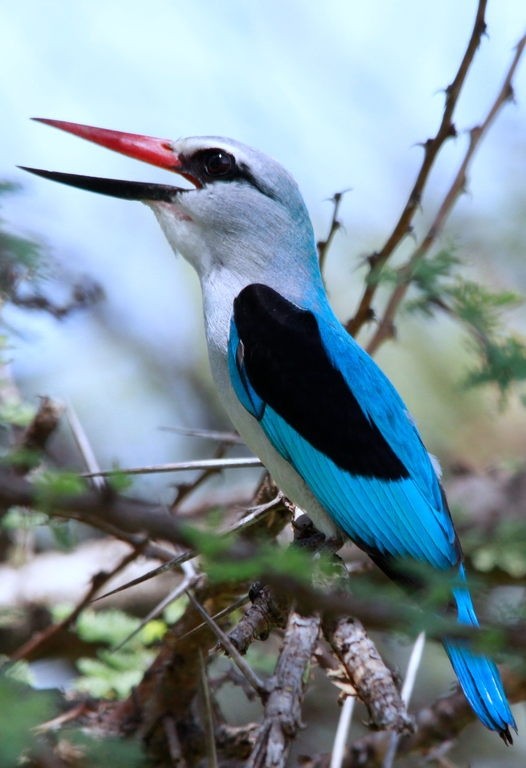Woodland Kingfisher
A species of Typical Woodland Kingfishers Scientific name : Halcyon senegalensis Genus : Typical Woodland Kingfishers
Woodland Kingfisher, A species of Typical Woodland Kingfishers
Botanical name: Halcyon senegalensis
Genus: Typical Woodland Kingfishers
Content
Description People often ask General Info
Description
This is a medium-sized kingfisher, 23 cm (9.1 in) in length. The adult has a bright blue back, wing panel and tail. Its head, neck and underparts are white, and its shoulders are black. The flight of the woodland kingfisher is rapid and direct. The large bill has a red upper mandible and black lower mandible. The legs and feet are dark grey. Some birds may have greyish heads, causing confusion with mangrove kingfisher. However, the lores are dark, creating a dark stripe through the eye (the stripe does not extend through the eye in mangrove kingfisher), and the underwing, primaries and secondaries are black with white underwing coverts (there is a black carpal patch on the white coverts in mangrove kingfisher). The inner webs of the base of the flight feathers are white, creating an indistinct white wingbar (white completely absent from wings in mangrove kingfisher). The breast is white (tends to be much greyer in mangrove kingfisher). The sexes are similar, but juveniles are duller than adults and have a brown bill. The call of this noisy kingfisher is a loud trill sounding like a nail run down the teeth of a comb. 
Size
23 cm
Nest Placement
Tree
Feeding Habits
Woodland Kingfisher, an insectivorous bird, predominantly feeds on insects like grasshoppers and bees. Employing a perch-and-pounce technique from exposed or shaded perches, it capitalizes on its keen eyesight to locate prey, occasionally expanding its diet with small vertebrates, showcasing opportunistic feeding adaptability.
Habitat
Woodland Kingfisher inhabits various wooded environments predominantly in tropical regions south of the Sahara. Its habitats range from riverine and savanna woodlands to open forests with Acacia trees, and areas close to human residences, such as farmland, parks, and gardens. While woodland Kingfisher may be named 'kingfisher', it is not strictly associated with aquatic environments and often favors drier landscapes. Typically found at elevations from sea level up to 1500m, and occasionally at heights up to 2000m, woodland Kingfisher adjusts seasonally with migrations towards equatorial zones during dry periods.
Dite type
Piscivorous
People often ask
General Info
Feeding Habits
Bird food type
Behavior
The woodland kingfisher is aggressively territorial, attacking intruders including humans. It has a striking display in which the wings are spread to show the white linings. 
Distribution Area
The woodland kingfisher is widely distributed in tropical Africa south of the Sahara and from Pretoria northwards. This kingfisher is essentially resident within 8° of the equator, but northern and southern populations are migratory, moving into the equatorial zone in the dry season. It is a common species of a variety of wooded habitats with some trees, especially Acacias, including around human habitation. Although it is a "kingfisher", it prefers drier habitats in more traditional woodland and can be far from water. It is often solitary but can occur in small groups. 
Species Status
Not globally threatened.
